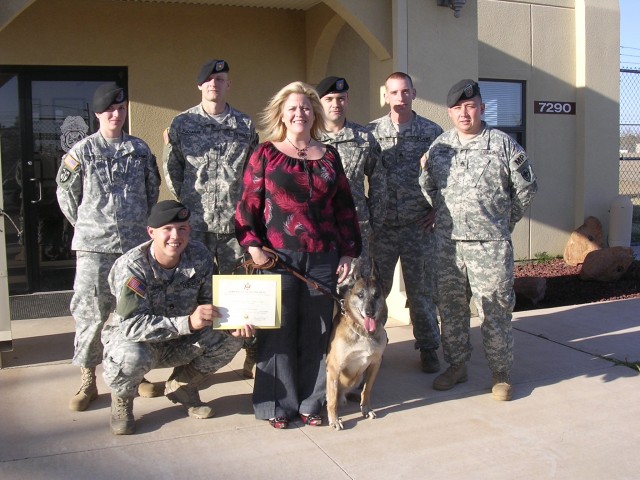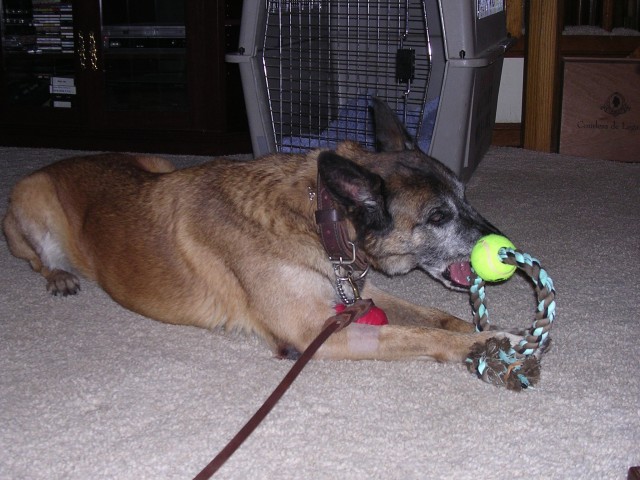Like many veterans, Sgt. 1st Class Rocky was looking forward to a long, lazy retirement, full of long walks, naps and some rousing games of ball. He'd earned the downtime after multiple deployments, hours on guard duty and some medical issues, including a partial amputation.
But unlike most veterans, Rocky couldn't simply enjoy his retirement party, take his pension and move on to another job or a relaxing retirement in Florida. Rocky, otherwise known as Rocky B-106, isn't your average veteran.
He's an 11-year-old Belgian Malinois, a military working dog trained in bomb detection. Well-trained and loved by his handlers, Rocky had been through multiple deployments, but his age and medical problems meant it was time to go.
Rocky, in other words, was "excess." A few years ago, that would have been a death sentence, but a 2000 law made the excess dogs available for adoption by civilians, after meeting a few criteria. According to Sgt. 1st Class Tedd Perry, kennel master at Fort Meade, Md., each dog must first be evaluated for its suitability for family life, as many have been trained as guard and attack dogs.
Handlers put the dogs through a range of tests, record them and send the tapes to the Department of Defense Dog Center at Lackland Air Force Base, Texas, for a panel to review. The panel makes the final decision on a dog's adoptability.
"I would say by the time these dogs come up for retirement, at that point, they're ready for real life, and I would say a good 90 percent of them are adoptable," Perry explained. "It's a great program. These dogs served their country just like Soldiers do, so at the end of their tour of service, it's nice for them...to be able to go home and be a house dog for a little while."
"The thought of a dog being destroyed, especially a dog that's given years of military service, is a real tragedy," added Sgt. Anthony Moll of the Fort Meade kennel. "So to know that there are plenty of dogs who will see a good home, who will get to lay on the carpet and run around the yard, it's a really good thought."
The age a dog is ready to retire really depends on the dog. Both Perry and Moll explained that some dogs are ready for retirement at age six, while others are still going strong at 12, but that the average age is nine or 10. As in Rocky's case, retirement is often due to health reasons, or sometimes because the dog is simply no longer interested in doing its job.
"There's not that much of an adjustment. Once they're deemed retireable...we don't take them out to work anymore. So instead of going out doing strict obedience, doing patrol training, detection training, we just take them out, play fetch, play with them. Their working time is over. We have fun with them until we can find a good home for them," Perry said.
Dogs' current handlers have priority when it comes to adoption, followed by former handlers, according to Perry, who said this is what usually happens. Some dogs are still capable of working in a less demanding environment and can go to civilian law-enforcement agencies as well. If a dog is deemed too violent to be adoptable, or simply is not adopted, it will eventually be euthanized.
Rocky, who deployed to Iraq several times during his assignment at Fort Sill, Okla., was one of the lucky ones. He found a new home, with Jeff and Becky Spencer and their Rat Terrier-mix, Sophia, just a few hours outside Fort Sill. Spencer had known of the adoption program from his time in the Air Force (when he even filled in as a kennel master) and wanted to give a fellow veteran a good home.
He contacted Debbie Kandoll at Military Working Dog Adoptions for help finding a dog, although anyone interested in adopting an MWD can contact the MWD headquarters at Lackland AFB directly, or call kennels at local installations. Perry said this was the best option because local kennel masters will know their dogs' personalities and which are ready to retire. Perry already has about five people on a waiting list in case a dog becomes available at Fort Meade, and is on a waiting list himself to adopt a dog he used to handle at Fort Carson, Colo.
"That dog and I spent three to four years together. We trained together. We worked together, lived together over there. (There's) no telling how many lives he saved over there just with his nose, sniffing out those bombs. He was the most loyal partner I've ever had, so if I get the chance, I will pick him up and bring him home," Perry explained.
Kandoll, who provides a list of kennel phone numbers on the MWD Adoptions Web site, cautioned that the process can take months, but the Spencers found Rocky after only one false start. They live in Oklahoma and made the short trip to Fort Sill to meet Rocky-although new owners have been known to travel cross-country or even internationally to find their MWD-immediately falling in love with the friendly Belgian Malinois.
They were able to bring Rocky home a few weeks later in November 2008, after the paperwork was complete (new pet parents must release the Army of any liability regarding the dog), and Army veterinarians removed a growth. Rocky is also blind in one eye and had his tail clipped after getting it caught in too many fences. According to Perry, the Army takes care of dogs' medical needs before adopting them out, and ensures the animals are spayed or neutered. He added that the Army will usually provide a month's supply of the dog's medications, but after that the dog's medical needs are the new owner's responsibility.
In addition to providing Rocky's hip and eye medication, the Fort Sill kennel master gave the Spencers Rocky's favorite ball, collar and leash. It was a bittersweet parting and Spencer remembers how sad the MWD Soldiers were to see Rocky go. They demonstrated Rocky's commands for the Spencers and gave them pointers to help Rocky and his new sister Sophia get along. The Soldiers even gave Rocky a retirement ceremony, complete with award, to mark his years of faithful service.
From there it was a smooth transition from working dog to spoiled pet. Rocky and Sophia bonded and quickly figured out their individual roles in the family pack, while Rocky immediately took to his new "parents" and life of leisure.
"He likes to play with his Kong toy, tennis ball and the big red ball the detachment sent with Rocky," said Spencer. "He enjoys searching and 'finding' things, maybe from his 'bomb dog' days. He enjoys going for walks and 'patrolling' the house and his backyard. Even though he's retired, he still has his training inside him, so he's every bit an MWD.
"After spending most of his life sleeping on concrete when he wasn't 'working,' he's enjoying his soft doggie bed. He also enjoys sleeping or resting on couches, chairs and we catch him sleeping on our bed often when we're not home.
"He seems to be wanting to relive his 'puppyhood' by the way he likes to play with Sophia, twist and scratch his back on the carpet, play with...toys," Spencer added. "He also enjoys chasing squirrels. He likes to lie on the floor and play with you, or will push up against you when he wants to be scratched or wants some affection. He follows me around the house all the time, wanting to know what I'm doing or afraid he'll miss out on something. I swear if he could speak, he'd be asking questions like a 5-year-old."
According to Perry, many MWDs like Rocky immediately settle into family life. Because the military looks for dogs that are already eager to please their handlers, they will likely be loyal to their new families, and the dogs also come well trained, well behaved and make good watch dogs.
Spencer initially worried that Rocky would think his carpeting was synonymous with grass and relieve himself indoors, but he hasn't had a problem. He's just a great pet, said Spencer, adding that he would recommend the adoption program, but suggested anyone considering an MWD take the time to educate themselves on the dogs' needs and personalities.
"(An MWD) would make an excellent pet, because...they've served their country just like a Soldier and they deserve their time to just be a dog, lay on the couch in front of a fireplace, run around the yard for awhile in their last years," said Perry.
Sgt. 1st Class Rocky likes to sneak onto his owners' bed, after years of sleeping on concrete.
For more information about military working dog adoptions, visit www.militaryworkingdogadoptions.com or www.lackland.af.mil/units/341stmwd/index.asp.










Social Sharing